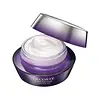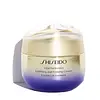What's inside
What's inside
 Key Ingredients
Key Ingredients

 Benefits
Benefits

 Concerns
Concerns

 Ingredients Side-by-side
Ingredients Side-by-side

Water
Skin ConditioningButylene Glycol
HumectantHydrogenated Polydecene
EmollientGlycerin
HumectantLimnanthes Alba Seed Oil
Skin ConditioningHydrogenated Lecithin
EmulsifyingDiphenylsiloxy Phenyl Trimethicone
Skin ConditioningCetearyl Alcohol
EmollientAdenosine
Skin ConditioningArginine
MaskingBetula Platyphylla Japonica Juice
Skin ConditioningCamellia Sinensis Leaf Extract
AntimicrobialDimethylsilanol Hyaluronate
HumectantGlycyrrhiza Glabra Leaf Extract
Skin ConditioningHydroxyproline
Skin ConditioningRhodomyrtus Tomentosa Fruit Extract
HumectantTocopherol
AntioxidantTremella Fuciformis Extract
HumectantVitis Vinifera Fruit Extract
Skin ConditioningBehenyl Alcohol
EmollientCarbomer
Emulsion StabilisingDimethicone
EmollientDisodium EDTA
Disodium Succinate
MaskingEctoin
Skin ConditioningHydrogenated Polyisobutene
EmollientLauryl Polyglyceryl-3 Polydimethylsiloxyethyl Dimethicone
Skin ConditioningPhytosterols
Skin ConditioningPhytosteryl Macadamiate
Skin ConditioningPhytosteryl Oleate
Skin ConditioningPhytosteryl/Behenyl/Octyldodecyl Lauroyl Glutamate
Skin ConditioningPolyglycerin-3
HumectantSodium Hydroxide
BufferingSodium Methyl Stearoyl Taurate
CleansingSuccinic Acid
BufferingXanthan Gum
EmulsifyingPhenoxyethanol
PreservativeParfum
MaskingHexyl Cinnamal
PerfumingLimonene
PerfumingLinalool
PerfumingWater, Butylene Glycol, Hydrogenated Polydecene, Glycerin, Limnanthes Alba Seed Oil, Hydrogenated Lecithin, Diphenylsiloxy Phenyl Trimethicone, Cetearyl Alcohol, Adenosine, Arginine, Betula Platyphylla Japonica Juice, Camellia Sinensis Leaf Extract, Dimethylsilanol Hyaluronate, Glycyrrhiza Glabra Leaf Extract, Hydroxyproline, Rhodomyrtus Tomentosa Fruit Extract, Tocopherol, Tremella Fuciformis Extract, Vitis Vinifera Fruit Extract, Behenyl Alcohol, Carbomer, Dimethicone, Disodium EDTA, Disodium Succinate, Ectoin, Hydrogenated Polyisobutene, Lauryl Polyglyceryl-3 Polydimethylsiloxyethyl Dimethicone, Phytosterols, Phytosteryl Macadamiate, Phytosteryl Oleate, Phytosteryl/Behenyl/Octyldodecyl Lauroyl Glutamate, Polyglycerin-3, Sodium Hydroxide, Sodium Methyl Stearoyl Taurate, Succinic Acid, Xanthan Gum, Phenoxyethanol, Parfum, Hexyl Cinnamal, Limonene, Linalool
Water
Skin ConditioningButylene Glycol
HumectantDimethicone
EmollientGlycerin
HumectantAlcohol Denat.
AntimicrobialPPG-3 Dipivalate
Skin ConditioningGlyceryl Stearate Se
EmulsifyingCetyl Alcohol
EmollientPentaerythrityl Tetraethylhexanoate
EmollientHydrogenated Polydecene
EmollientMyristyl Myristate
EmollientPEG-100 Stearate
Silica
AbrasiveBis-Diglyceryl Polyacyladipate-2
EmollientPotassium Methoxysalicylate
BleachingBehenyl Alcohol
EmollientSodium Acrylate/Sodium Acryloyldimethyl Taurate Copolymer
Emulsion StabilisingStearyl Alcohol
EmollientPolyvinyl Alcohol
Phenoxyethanol
PreservativeIsohexadecane
EmollientParfum
MaskingPolysorbate 80
EmulsifyingSorbitan Tristearate
EmulsifyingTrisodium EDTA
Erythritol
HumectantPEG/PPG-14/7 Dimethyl Ether
Skin ConditioningPEG/PPG-17/4 Dimethyl Ether
Skin ConditioningTocopheryl Acetate
AntioxidantRosa Damascena Flower Water
MaskingSodium Citrate
BufferingSuccinoglycan
Skin ConditioningAlcohol
AntimicrobialSorbitan Oleate
EmulsifyingCaffeine
Skin ConditioningCitric Acid
BufferingSodium Metaphosphate
BufferingLavandula Angustifolia Oil
MaskingPhytosteryl/Octyldodecyl Lauroyl Glutamate
Skin ConditioningLimonene
PerfumingHexyl Cinnamal
PerfumingTocopherol
AntioxidantLinalool
PerfumingCitronellol
PerfumingSodium Metabisulfite
AntioxidantCI 77492
Cosmetic ColorantAngelica Acutiloba Root Extract
Skin ConditioningAngelica Keiskei Leaf/Stem Extract
Skin ConditioningOlea Europaea Leaf Extract
PerfumingLamium Album Flower/Leaf/Stem Extract
Skin ConditioningCellulose
AbsorbentCamellia Sinensis Leaf Extract
AntimicrobialInositol
HumectantCarthamus Tinctorius Flower Extract
Skin ConditioningCI 77491
Cosmetic ColorantZiziphus Jujuba Fruit Extract
Skin ConditioningRosmarinus Officinalis Leaf Extract
AntimicrobialHydrolyzed Silk
HumectantBupleurum Falcatum Root Extract
Skin ConditioningWater, Butylene Glycol, Dimethicone, Glycerin, Alcohol Denat., PPG-3 Dipivalate, Glyceryl Stearate Se, Cetyl Alcohol, Pentaerythrityl Tetraethylhexanoate, Hydrogenated Polydecene, Myristyl Myristate, PEG-100 Stearate, Silica, Bis-Diglyceryl Polyacyladipate-2, Potassium Methoxysalicylate, Behenyl Alcohol, Sodium Acrylate/Sodium Acryloyldimethyl Taurate Copolymer, Stearyl Alcohol, Polyvinyl Alcohol, Phenoxyethanol, Isohexadecane, Parfum, Polysorbate 80, Sorbitan Tristearate, Trisodium EDTA, Erythritol, PEG/PPG-14/7 Dimethyl Ether, PEG/PPG-17/4 Dimethyl Ether, Tocopheryl Acetate, Rosa Damascena Flower Water, Sodium Citrate, Succinoglycan, Alcohol, Sorbitan Oleate, Caffeine, Citric Acid, Sodium Metaphosphate, Lavandula Angustifolia Oil, Phytosteryl/Octyldodecyl Lauroyl Glutamate, Limonene, Hexyl Cinnamal, Tocopherol, Linalool, Citronellol, Sodium Metabisulfite, CI 77492, Angelica Acutiloba Root Extract, Angelica Keiskei Leaf/Stem Extract, Olea Europaea Leaf Extract, Lamium Album Flower/Leaf/Stem Extract, Cellulose, Camellia Sinensis Leaf Extract, Inositol, Carthamus Tinctorius Flower Extract, CI 77491, Ziziphus Jujuba Fruit Extract, Rosmarinus Officinalis Leaf Extract, Hydrolyzed Silk, Bupleurum Falcatum Root Extract
 Reviews
Reviews

Ingredients Explained
These ingredients are found in both products.
Ingredients higher up in an ingredient list are typically present in a larger amount.
Behenyl Alcohol is a type of fatty alcohol (these are different from the drying, solvent alcohols).
Fatty Alcohols have hydrating properties and are most often used as an emollient or to thicken a product. They are usually derived from natural fats and oils; behenyl alcohol is derived from the fats of vegetable oils.
Emollients help keep your skin soft and hydrated by creating a film that traps moisture in.
In 2000, Behenyl Alcohol was approved by the US as medicine to reduce the duration of cold sores.
Learn more about Behenyl AlcoholButylene Glycol (or BG) is used within cosmetic products for a few different reasons:
Overall, Butylene Glycol is a safe and well-rounded ingredient that works well with other ingredients.
Though this ingredient works well with most skin types, some people with sensitive skin may experience a reaction such as allergic rashes, closed comedones, or itchiness.
Learn more about Butylene GlycolCamellia Sinensis Leaf Extract is derived from the leaves of the tea plant. Black tea, green tea, and oolong tea are all harvested from this plant.
This ingredient has many skin benefits:
This ingredient contains polyphenols, a strong antioxidant. Antioxidants help fight off molecules that damage skin cells.
On top of that, the antioxidants in green tea neutralize free-radicals from the sun. This gives the skin some extra UV protection, but should not replace sunscreen.
Many components of tea have anti-inflammatory properties.
Polyphenols and L-theanine help soothe the skin and reduce irritation. The caffeine in Camellia Sinensis Leaf Extract helps calm inflamed blood vessels.
Other compounds found in tea include: Vitamin Bs, linoleic acid, magnesium, calcium, iron, and zinc.
Research has shown both drinking Camellia Sinensis Leaf Tea and applying it to the skin can help boost skin elasticity and hydration. Studies also show using tea extract may reduce sebum, or oil, production.
Learn more about Camellia Sinensis Leaf ExtractDimethicone is a type of synthetic silicone created from natural materials such as quartz.
What it does:
Dimethicone comes in different viscosities:
Depending on the viscosity, dimethicone has different properties.
Ingredients lists don't always show which type is used, so we recommend reaching out to the brand if you have questions about the viscosity.
This ingredient is unlikely to cause irritation because it does not get absorbed into skin. However, people with silicone allergies should be careful about using this ingredient.
Note: Dimethicone may contribute to pilling. This is because it is not oil or water soluble, so pilling may occur when layered with products. When mixed with heavy oils in a formula, the outcome is also quite greasy.
Learn more about DimethiconeGlycerin is already naturally found in your skin. It helps moisturize and protect your skin.
A study from 2016 found glycerin to be more effective as a humectant than AHAs and hyaluronic acid.
As a humectant, it helps the skin stay hydrated by pulling moisture to your skin. The low molecular weight of glycerin allows it to pull moisture into the deeper layers of your skin.
Hydrated skin improves your skin barrier; Your skin barrier helps protect against irritants and bacteria.
Glycerin has also been found to have antimicrobial and antiviral properties. Due to these properties, glycerin is often used in wound and burn treatments.
In cosmetics, glycerin is usually derived from plants such as soybean or palm. However, it can also be sourced from animals, such as tallow or animal fat.
This ingredient is organic, colorless, odorless, and non-toxic.
Glycerin is the name for this ingredient in American English. British English uses Glycerol/Glycerine.
Learn more about GlycerinHexyl Cinnamal is a fragrance ingredient with a similar scent to jasmine. It can be naturally found in chamomile essential oil.
This ingredient is a known EU allergen and may sensitize the skin. The EU requires this ingredient to be listed separately on an ingredients list.
Hexyl Cinnamal is not water soluble but is soluble in oils.
Learn more about Hexyl CinnamalHydrogenated Polydecene is an emollient. It creates a non-occlusive film on the skin that offers extra protection for your skin barrier.
The texture of Hydrogenated Polydecene ranges from light and silky to rich.
Hydrogenated Polydecene is the end compound of controlled hydrogenation of Polydecene.
Learn more about Hydrogenated PolydeceneLimonene is a fragrance that adds scent and taste to a formulation.
It's found in the peel oil of citrus fruits and other plants such as lavender and eucalyptus. The scent of limonene is generally described as "sweet citrus".
Limonene acts as an antioxidant, meaning it helps neutralize free radicals.
When exposed to air, oxidized limonene may sensitize the skin. Because of this, limonene is often avoided by people with sensitive skin.
The term 'fragrance' is not regulated in many countries. In many cases, it is up to the brand to define this term. For instance, many brands choose to label themselves as "fragrance-free" because they are not using synthetic fragrances. However, their products may still contain ingredients such as essential oils that are considered a fragrance.
Learn more about LimoneneLinalool is a fragrance and helps add scent to products. It's derived from common plants such as cinnamon, mint, citrus, and lavender.
Like Limonene, this ingredient oxidizes when exposed to air. Oxidized linalool can cause allergies and skin sensitivity.
This ingredient has a scent that is floral, spicy tropical, and citrus-like.
Learn more about LinaloolParfum is a catch-all term for an ingredient or more that is used to give a scent to products.
Also called "fragrance", this ingredient can be a blend of hundreds of chemicals or plant oils. This means every product with "fragrance" or "parfum" in the ingredients list is a different mixture.
For instance, Habanolide is a proprietary trade name for a specific aroma chemical. When used as a fragrance ingredient in cosmetics, most aroma chemicals fall under the broad labeling category of “FRAGRANCE” or “PARFUM” according to EU and US regulations.
The term 'parfum' or 'fragrance' is not regulated in many countries. In many cases, it is up to the brand to define this term.
For instance, many brands choose to label themselves as "fragrance-free" because they are not using synthetic fragrances. However, their products may still contain ingredients such as essential oils that are considered a fragrance by INCI standards.
One example is Calendula flower extract. Calendula is an essential oil that still imparts a scent or 'fragrance'.
Depending on the blend, the ingredients in the mixture can cause allergies and sensitivities on the skin. Some ingredients that are known EU allergens include linalool and citronellol.
Parfum can also be used to mask or cover an unpleasant scent.
The bottom line is: not all fragrances/parfum/ingredients are created equally. If you are worried about fragrances, we recommend taking a closer look at an ingredient. And of course, we always recommend speaking with a professional.
Learn more about ParfumPhenoxyethanol is a preservative that has germicide, antimicrobial, and aromatic properties. Studies show that phenoxyethanol can prevent microbial growth. By itself, it has a scent that is similar to that of a rose.
It's often used in formulations along with Caprylyl Glycol to preserve the shelf life of products.
Tocopherol (also known as Vitamin E) is a common antioxidant used to help protect the skin from free-radicals and strengthen the skin barrier. It's also fat soluble - this means our skin is great at absorbing it.
Vitamin E also helps keep your natural skin lipids healthy. Your lipid skin barrier naturally consists of lipids, ceramides, and fatty acids. Vitamin E offers extra protection for your skin’s lipid barrier, keeping your skin healthy and nourished.
Another benefit is a bit of UV protection. Vitamin E helps reduce the damage caused by UVB rays. (It should not replace your sunscreen). Combining it with Vitamin C can decrease sunburned cells and hyperpigmentation after UV exposure.
You might have noticed Vitamin E + C often paired together. This is because it is great at stabilizing Vitamin C. Using the two together helps increase the effectiveness of both ingredients.
There are often claims that Vitamin E can reduce/prevent scarring, but these claims haven't been confirmed by scientific research.
Learn more about TocopherolWater. It's the most common cosmetic ingredient of all. You'll usually see it at the top of ingredient lists, meaning that it makes up the largest part of the product.
So why is it so popular? Water most often acts as a solvent - this means that it helps dissolve other ingredients into the formulation.
You'll also recognize water as that liquid we all need to stay alive. If you see this, drink a glass of water. Stay hydrated!
Learn more about Water